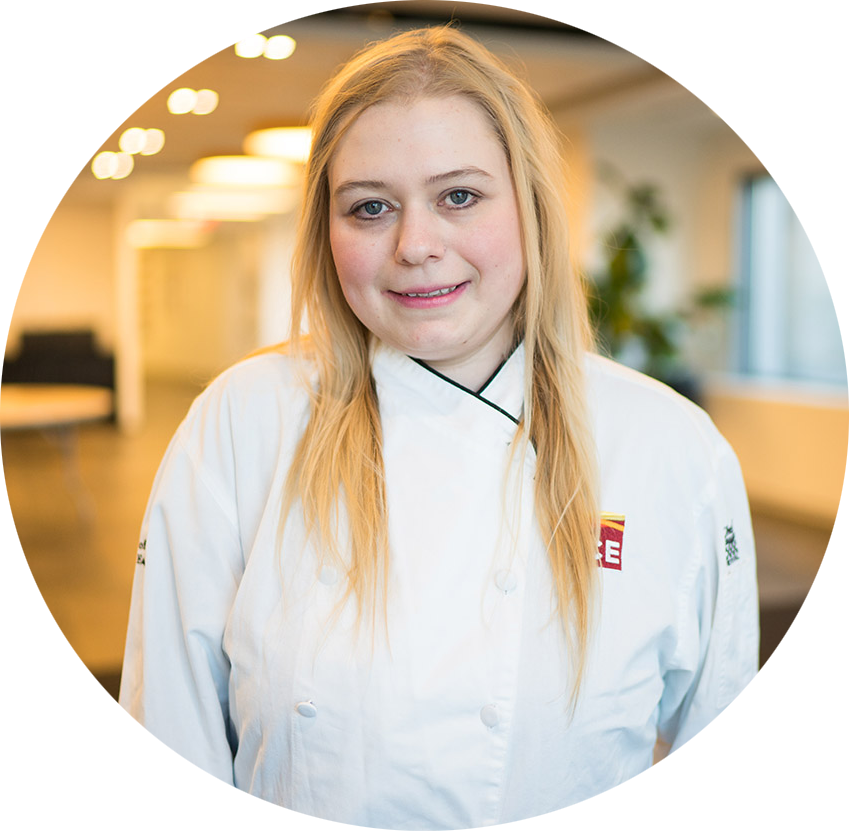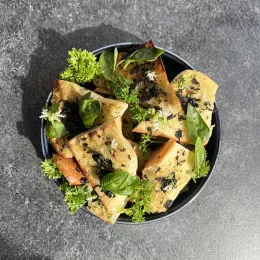Fermented red pepper relish is a topping that will be sure to be on repeat all through the warm summer months. Consider adding it to anything, from seaside dining to ballpark cuisine.
Fermenting bell peppers highlights their sweetness while preserving their natural crunch. Showcasing the red-hued peppers was a deliberate effort made to liven up the typical green relish found on grocery store shelves.
Adding yellow mustard seeds and celery seeds to the ferment complements the bell peppers while making the flavors more multi-dimensional, and white onions and Thai chiles chime in to add a bit of a piquant flavor. Raw apple cider vinegar is used to jump-start the ferment and to help maximize crunch.
Since roasted red bell pepper hummus is such a popular combination, piling the fermented red pepper relish onto hummus forges a seamless narrative. The brine is synchronously used to impart complexity and disperse even more of those sought-after probiotic qualities.
Good to Know with Chef Olivia:
- Be sure to use a sharp knife when dicing your peppers, as cuts are important here since this ferment is designed to be used as a topping.
- This fermented red pepper relish is excellent for any seafood or plant-based sea-inspired dishes — mix it into mayo for tartar sauce, dollop it onto crab or jackfruit cakes, whip it up a remoulade or use it as a mignonette to adorn a platter of oysters.
- Add your fermented red pepper relish generously onto the top perimeter of hot dogs or your favorite plant-based hot dog alternative.
- For extra-fluffy hummus, peel off and discard the majority of the chickpea skins. You can also throw in a few ice cubes while processing the hummus for an even fluffier effect.
- Try using orange or yellow bell peppers or a mix of different colors for even more variety.

Ingredients
For the Sweet & Spicy Red Pepper Relish:
Yield: 1 quart-sized jar
- 4 red bell peppers, cut into fine small dice
- 3 red Thai chiles, finely chopped
- 1 small white onion, cut into fine small dice
- 1 tablespoon sea salt
- 3 tablespoons sugar
- 1 teaspoon red chile flakes
- 2 teaspoons yellow mustard seeds
- 1/2 teaspoon celery seeds
- 1/2 cup raw apple cider vinegar
- water, to cover
For the Fermented Red Pepper Relish Chickpea Hummus and Assembly:
- 3 cups cooked chickpeas
- 2 garlic cloves, minced into a paste
- 2 tablespoons tahini
- 2 tablespoons olive oil, more for garnish
- 1/4 cup red pepper relish brine
- 1 teaspoon salt
- 1/4 cup red pepper relish, plus more for garnish
- Pita bread, cut into triangles
- 1 cup Kalamata olives
- 2 English cucumbers, cut into batons
- 2 bunches baby carrots
Directions
For the Sweet & Spicy Red Pepper Relish:
- Add finely diced red bell peppers, Thai chiles and onion to a large bowl.
- Add in sea salt, sugar, red chile flakes, mustard seeds and celery seeds. Gently massage to release some liquid from the vegetables.
- Allow mixture to sit for 5 minutes.
- Fold in apple cider vinegar.
- Pack mixture into a sterilized, quart-sized glass jar along with any liquid created in the massaging process.
- Add fermentation weight.
- Cover with water until the level reaches the top of the bottom rim.
- Fasten an airlock lid and ferment at room temperature for 7 days.
- Transfer to refrigerator for extended storage.
For the Fermented Red Pepper Relish Chickpea Hummus and Assembly:
- Place chickpeas, minced garlic, tahini, olive oil, brine and salt into a food processor and pulse for a few minutes or until completely smooth.
- Transfer to a serving dish. Garnish with olive oil and red pepper relish.
- Serve with pita, Kalamata olives and cut vegetables.






